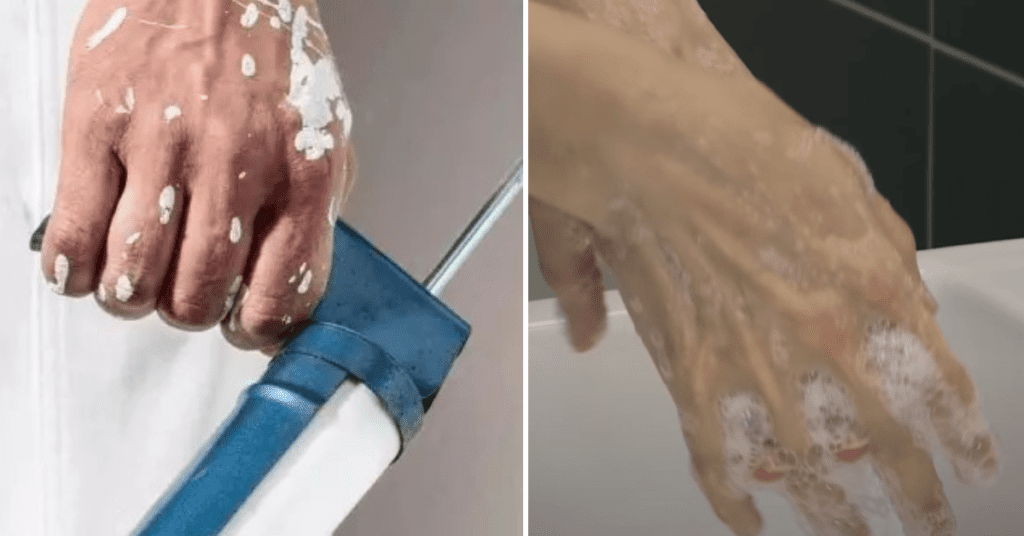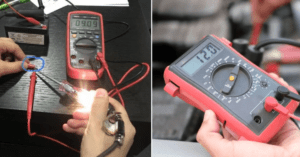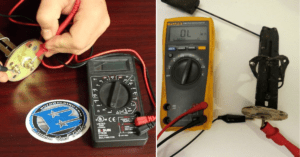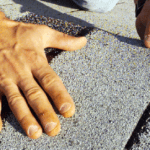How to Get Caulk Off Hands Safely and Effectively
Removing the last traces of caulk from your hands can be a complete nightmare. Not only can it ruin your clothes with messy smudges, but cleaning up the sticky, glue-like residue without getting it in your eyes or mouth is a challenge in itself. A superficial cleanse is often insufficient. Whether you’re a professional or simply tackling DIY projects at home, you may not always have the luxury of time for this tiresome process. That’s why we’ve compiled a comprehensive guide, on how to get caulk off hands safely and effectively in no time! Read on for tips on using common household items and store-bought solutions that won’t irritate your skin or cause any long-term damage.

Tools and Materials Needed for Removing Caulk
- Soap or Hand Cleaner
- Oil or Petroleum Jelly
- Pumice Stone or Emery Board (for tougher residues)
- Gloves (for future caulk applications)
Safety Precautions for caulk removal
- Avoid using harsh chemicals, such as acetone or paint thinner, as they can strip your skin of its natural oils and cause irritation.
- Wear protective gloves to avoid direct contact with caulk or any cleaning agents.
- Do not use sharp objects like knives or razors to scrape off caulk residue as they may cause injury.
- Some individuals may experience skin irritation or allergic reactions to certain caulk materials. If you notice any redness, swelling, or itching while removing caulk, stop immediately and seek medical attention.
3 Immediate Steps for Caulk Removal
Step 1: Avoiding Spreading and Smearing
- As soon as you notice caulk on your hands, avoid touching any surfaces or objects. This will prevent the spreading of the residue and make a bigger mess.
- Try not to rub your hands together vigorously, as this can smear the caulk and make it more difficult to remove.
Step 2: Use a Dry Cloth or Paper Towel
- Gently wipe off as much caulk residue as possible with a dry cloth or paper towel.
- Do not use water at this stage, as it can make the caulk stickier and harder to remove.
Step 3: Avoiding Water (for silicone-based caulks)
- If the caulk is silicone-based, avoid using water at all costs. Instead, use oil or petroleum jelly to break down the residue.
4 Easy Step-by-Step Methods for Removing Caulk
Method 1: Soap and Water
- If the caulk is water-based, washing your hands with soap and warm water may be sufficient.
- Lather up a generous amount of soap and gently scrub your hands together, paying special attention to the areas with caulk residue.
- Rinse off with warm water and dry your hands thoroughly with a towel.
Method 2: Oil or Petroleum Jelly
- For silicone-based caulk, use oil or petroleum jelly to break down the residue.
- Apply a generous amount of oil or jelly onto your hands and rub them together, focusing on the areas with caulk residue.
- Let it sit for a few minutes to allow the caulk to dissolve.
- Gently scrub your hands with soap and warm water until all the residue is removed.
- Rinse and dry your hands thoroughly.
Method 3: Pumice Stone or Emery Board
- For tougher caulk residues, a pumice stone or emery board can be used to gently scrub off the residue.
- Wet the affected areas with warm water and use the pumice stone or emery board in circular motions to remove the residue.
- Rinse off with warm water and dry your hands thoroughly.
Method 4: Combining Methods for Stubborn Residue
- If the caulk residue is particularly stubborn, you may need to combine methods for effective removal.
- Start with method 2 (oil or petroleum jelly) and let it sit for a few minutes before using a pumice stone or emery board in circular motions.
- Rinse off with warm water and dry your hands thoroughly.
Aftercare and Skin Hydration
Thoroughly Rinsing Hands: After employing any of the above methods to clean your hands, it is crucial to rinse them meticulously with warm water. Allow the water to flow across every nook and cranny of your hands, ensuring that all traces of dirt, germs, and soap residue are thoroughly washed away. Take your time to ensure that each finger, the spaces between them, and the back of your hands receive adequate rinsing. Finally, gently pat your hands dry with a clean towel or let them air dry completely. This attention to detail in hand, rinsing will help maintain optimal hygiene and minimize the risk of spreading harmful pathogens.
Moisturizing and Soothing the Skin: After removing caulk residue from your hands, it’s essential to replenish moisture and soothe any irritation or dryness caused by the cleaning process. You can use a gentle hand cream or lotion to hydrate your skin and promote healing. Additionally, if you experience any discomfort or redness, applying aloe-Vera gel can help soothe the skin and reduce inflammation.
Monitoring for Skin Irritation: In some cases, individuals may experience skin irritation or allergic reactions after coming into contact with certain types of caulk. If you notice any redness, swelling, or itching on your hands after removing the caulk, it’s best to seek medical attention and avoid using the same caulk material in the future.
Additional Tips for Prevention and Safety for Caulk Removal
- Always wear protective gloves when working with caulk to avoid direct contact with your skin.
- Use caution when handling sharp tools or objects while removing caulk residue.
- Avoid using harsh chemicals and opt for safer, natural cleaning solutions whenever possible.
- After applying caulk, dispose of any excess residue immediately to prevent it from drying onto surfaces and becoming harder to remove.
- Regularly clean and disinfect your caulk removal tools to prevent the spread of bacteria and germs.
By following these safety precautions and using the appropriate removal methods, you can effectively remove caulk residue from your hands without causing irritation or long-term damage to your skin.
Dealing with Allergic Reactions or Irritation
- In case of an allergic reaction or severe skin irritation, seek medical attention immediately.
- Inform your doctor about the type of caulk you were exposed to and any symptoms you are experiencing for proper diagnosis and treatment.
- Avoid contact with the same type of caulk in the future to prevent further reactions.
FAQs for How to Get Caulk Off Hands Safely and Effectively
Can I use nail polish remover to remove caulk residue from my hands?
No, it’s not recommended to use nail polish remover on your skin as it contains harsh chemicals that can cause irritation or dryness.
Is there a natural alternative to oil or petroleum jelly for silicone-based caulk removal?
Yes, you can use coconut oil or olive oil as a natural alternative.
How long does it take for caulk residue to fully dissolve with method 2 (oil or petroleum jelly)?
It typically takes around 5-10 minutes for the caulk residue to fully dissolve but may vary depending on the amount of residue and type of caulk.
Can I use a pumice stone on open cuts or wounds on my hands?
No, it’s not recommended to use a pumice stone or any abrasive tool on open wounds as it can cause further irritation and delay healing.
Conclusion
By following these four easy methods and taking proper aftercare precautions, you can safely and effectively remove caulk residue from your hands. Remember to thoroughly rinse your hands, moisturize and soothe the skin, and monitor for any allergic reactions or irritation. If necessary, seek medical attention for severe reactions or if symptoms persist. For further questions or concerns, consult a professional or seek additional resources on caulk removal. Stay safe and keep your hands clean! So, don’t let the thought of messy residue stop you from using caulk for home improvement projects. With the right tools and techniques, cleaning up after caulking can be a breeze. Happy caulking!
Keep in mind that these methods are specifically for removing caulk residue from your hands. For removing residue from other surfaces, such as countertops or floors, it is best to consult the manufacturer’s instructions or seek professional help. Additionally, always follow safety precautions and use appropriate tools when working with caulk to avoid any accidents or injuries. With a little bit of knowledge and proper care, you can easily handle any caulk residue and keep your hands clean and healthy.






